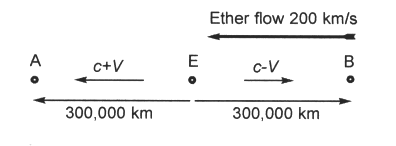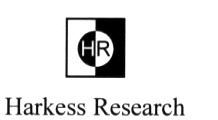 Wisp
Unification Theory - Reasons why Einstein was wrong
Wisp
Unification Theory - Reasons why Einstein was wrong
- Home
- About Me
- Reasons why Einstein was wrong
- One-way speed of light experiments
- Hot topic
- Q&A
- ACES - The end of Relativity
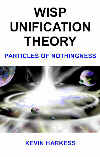
- Book Contents
- Introduction
- 1 Matter,Space and Time
- 2 Symmetry
- 3 Fractals
- 4 Wisp Space
- 5 Gravity
- 6 Electromagnetic Force
- 7 Wisp & S.R: Fundamentals
- 8 Wisp & S.R: Electrodynamics
- 9 Wisp & S.R: Doppler effect
- 10 Wisp & S.R: Relativistic Mechanics
- 11 Big bang
- Appendix A
- Appendix B
- Index A-Z
- Copyright
- Feedback
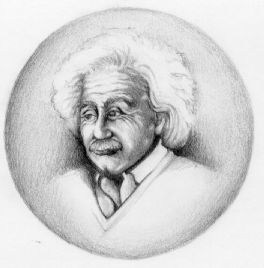
Albert Einstein
Reasons why Einstein was wrong
- The end of relativity (2026)
Atomic Clock Ensemble in Space (ACES) will mark the end of relativity. ACES is an European Space Agency (ESA) mission in fundamental physics based on the performances of a new generation of atomic clocks operated in the microgravity environment of the International Space Station (ISS). By comparing ACES's clocks to terrestrial clocks worldwide, precision tests of the special and general theory of relativity will be made with unprecedented resolution.
Relativity will fail when space and ground clocks reveal changes in the oneway speed of microwave signals used to compare clocks. Light's speed will be measured as c+v and c-v, and not c as Einstein thought. The changes in speed are due to the earth's motion through the ether.
Wisp theory also predicts a sidereal variation of around +/- 0.5nS when equator ground clocks are compared with ground clocks at higher latitudes - using ACES as the reference. The effect is caused by the earth rotating in the ether wind, and will provide further proof of ether's existence.
But first I will convince you that relativity is not only wrong it's fundamentally flawed.
- How relativity came about
In 1887, Michelson-Morley failed in their attempt to measure the earth's motion through the ether. How could science explain Maxwell's equations and Lorentz Force Law in terms of ether, if they couldn't detect it?
In 1905, Einstein provided an answer. He published a set of equations (special relativity) that allow the laws of physics to be the same for all inertial frames, dismissing the existence of ether.
But there was a snag:
> The one-way speed of light in a vacuum had to have the same measured value in all inertial frames. Ironically, this didn't mean the actual one-way speed of light had to be constant, but relativity must make it appear so when measured. Under relativity's rules, clocks are synchronized to ensure the speed of light stays constant, even though its actual speed could vary by +/-V (the observer's speed through the ether).
- Why it still survives
The world's media promoted Einstein to genius status, almost god like, helping establish special relativity - illogical though it is - as a fundamental pillar of modern physics. Undergraduates are told to accept it, not challenge it. If you question relativity, you challenge Einstein, take on the world, the odds are stacked against you, it's something you don't do.
The mathematical logic of relativity forms a closed loop, making it difficult (but not impossible) to challenge.
>According to relativity, space and time are joined, forming spacetime. But there is no way to prove spacetime actually exists. Absurd.
>According to relativity, moving objects undergo length contraction in their direction of motion. Again, there is no way to prove this.
>Relativity doesn't allow you to measure the actual one-way speed of light, but claims it is constant! But scientists have found ways to do this and the results prove relativity wrong.
Physicists are reluctant to challenge relativity, even though many know it's wrong. They fear ridicule, job loss, upsetting the status quo. Better to say nothing. Anyway, relativity works reasonably well. Admittedly, it has paradoxes, doesn't comply with commonsense logic, and is fundamentally flawed. But no one seems to care.
Physicists who do experiments and publish work that proves relativity false are ignored or labelled crackpot.
Physicists who support relativity, go on to develop "spacetime" theories, which include wormholes and multidimensional universes, yet fail to provide a single strand of proof they exist. Hardly surprising physics is in decline; it's lost its way and needs to get back on track. It needs a major overhaul.
We should be concentrating on ether theories that focus on a preferred frame of reference - commonsense 3-D space theories, which embed relativistic effects (time dilation, etc). Wisp unification theory is one such theory.
Why challenge Einstein?
- Einstein's relativity not only hindered the development of electromagnetic
theory - as Louis Essen put it, but has halted the development of aether
physics for over 100-years. Thanks to Einstein, it's impossible to have
a proper scientific discussion in this important field. Simply put,
relativity doesn't support the existence of aether.
Relativity is nonsense and must go
- Consider three clocks A, B, and C all moving in inertial frames.
You are in frame A, and see clock B moving away from you. So relativity
says clock B runs slower than clock A.
B sees clock C moving, and so according to relativity, C runs slower than B.
So clock A runs faster than B, and B runs faster than C. So clock A should be much faster than C.
Now if A and C happen to be in the same frame, they are equal, and both faster than B! So relativity is illogical and nonsense.
Supporters of relativity would baffle you with the usual rubbish explanation: "you cannot compare clocks this way because accelerations are involved"!!!
The reason why acceleration makes the result invalid is not clearly explained. And it has directional dependence, which makes a relative motion argument flawed.
They will argue that this is called the twins' paradox, but it's not really a paradox as it's fully explained by relativity.
Obviously you haven't been brainwashed into accepting it.
What would make sense is for clocks to run slower when in motion relative to an absolute ether frame.
- Other misconceptions of relativity are that the speed of light has
been accurately measured hundreds of times and supports Einstein's claim
that it is constant. And relativity has been tested more than any theory
and has worldwide support from the best scientist.
Really!!!
The one-way speed of light has NEVER been accurately measured because the rules of relativity don't allow it. Only light's two-way (round trip) speed has been accurately measured on earth. Soon accurate measurements of time from atomic clocks in space (ACES) will reveal that the one-way speed of light is affected by the earth's motion through an absolute ether frame. This will mark the end of relativity.
Relativity is fundamentally flawed
- A less-known fact about relativity is that it rigs the result so that
the speed of light is constant for all observers, even though the ACTUAL
speed of light could vary. It gets away with this because clocks are
synchronized Einstein's way - this is a convention used, it's not reality.
From then on, it gets wrongly reported that the speed of light in a
vacuum is a constant, and few challenge it. Worse still, it is used
to define the metre, but this has never been checked in practice.
To show what nonsense this is, we liken it to observers applying Einstein's clock synchronization method to a swimmer (Mr Photon), who swims at constant speed through water. Observers, A, and B, stand 100m apart, along the bank of the fast flowing river Ether. We know in reality, Mr Photon swims upstream (slower) and downstream (faster) because of the river's speed. However, both observers, A, and B, will claim that Mr Photon swam at constant speed both ways between them. Clearly this is wrong. By applying Einstein's clock synchronization to the river ether they get a fixed result, regardless of the river's speed. Likewise, the claim that the speed of light is constant is absurd. By synchronizing clocks Einstein's way the results are rigged. Relativity is fundamentally flawed.
I posted this flaw on two "serious" pro-relativity forums, seeking responses.
> Universe Today did not show it, and gave no response.
> Physicsforums did not show it. They sent me a message banning me forever and called me crackpot.
It's criminal that this nonsense theory of relativity continues to be taught as a fundamental pillar of modern physics. Einstein was not the genius we're led to believe, and his relativity theory is rigged and plain wrong. Many scientists know this, but say nothing. Those that speak out are ignored or called crackpot. The truth is relativity is fundamentally flawed - space and time are not joined; objects do not contract in length; the measured constant speed of light result is rigged by synchronizing clocks Einstein's way; the theory is riddled with paradoxes, and defies commonsense logic.
L. Essen who built the first caesium clock (later used to define the second) wrote - Wireless World 1978 - Relativity and time signals, "The continued acceptance and teaching of relativity hinders the development of electromagnetic theory". "The theory is so rigidly held that young scientists dare not openly express their doubts". He was advised not to criticize relativity or his career prospects would be spoilt.
Several scientists have provided proof that the speed of light is not constant, but is affected by an ether flow. Although their work is ignored by the mainstream, their findings are in remarkable agreement. Evidence that shows special relativity to be false is now overwhelming and is listed below in some order of importance:
Wisp theory's view
- Special relativity is unnecessary. Einstein introduced it simply to explain the Lorentz force law, as he believed an ether theory could not support it. However, he's wrong, see chapter 8 - equation set 8.4. It proves conclusively that there is no need for a special theory that joins space with time, as the ether medium can support the Lorentz force law and so endorse Lorentz symmetry.
- The second postulate of special relativity - the speed of light in a vacuum is constant for all inertial observers - has never been properly tested. The only tests carried out are based on two-way light speed measurements. These are not proper tests; as null results can be explained using a dilation factor know as jiggle. The only true test for the speed of light is to measure its speed one-way. It is truly amazing that a simple test using two clocks and a laser has never been done!
- Although Einstein may not have needed the Michelson-Morley "null" result to complete his special theory of relativity, there is no denying that it forms the experimental basis for his theory. But this "null" result can easily be explained using an ether model, see the Michelson Morley experiment.
- Special relativity is a simple theory, but it fails to comply with commonsense logic, and consequently paradoxes result. These issues are resolved by wisp relativity, which is a simple theory based on commonsense.
- A second test, to measure a moving observer's transverse Doppler effect also has never been done. It could be carried out on the International Space Station and it will prove that Einstein was wrong. Note: the affect of the Earth's gravity on the clock frequencies is insignificant and has not been included, see appendix A for details.
- Many distinguished professors claim that the predictions of special relativity's Doppler effect cannot be explained by reference to a fluid type ether medium. But this is not so, as calculations of wisp's Doppler effect prove that they match and better those predicted by Einstein. Indeed, special relativity's Doppler equations can be derived from wisp relativity through a limit process, see chapter 9.
- A third test that reveals a small offset in Fizeau's experiment shown in appendix B can be used to prove relativity is wrong.
Tests that have been carried out that show Einstein was wrong
- In October 2003, Hartwig Thim reported the "Absence of the relativistic
transverse doppler shift at microwave frequencies". An experiment showing
33 GHz signals received by rotating antennas is not exhibiting the frequency
shift "transverse Doppler effect" predicted by Einstein's relativistic
Doppler formula. This is predicted by wisp theory 9.2.1, which shows
special relativity's formula to be wrong. Thim's conclusion that a phenomenon
which depends on absolute velocities in the fundamental frame (ether)
is correct.
See, https://pdfs.semanticscholar.org/505b/3ba592f5d9d19153c27bf8032fc6c60527c9.pdf
- In August 2006, C E Navia et al report on a search for anisotropic
light propagation as a function of laser alignment relative to the Earth's
velocity vector. A laser diffraction experiment was conducted to study
light propagation in air. The experiment is easy to reproduce and it
is based on simple optical principles. Two optical sensors (segmented
photo-diodes) are used for measuring the position of diffracted light
spots with a precision better than 0.1 Ám. The goal is to look for signals
of anisotropic light propagation as function of the laser beam alignment
to the Earth's motion (solar barycenter motion) obtained by COBE. Two
raster search techniques have been used. First, a fixed laser beam in
the laboratory frame that scans due to Earth's rotation. Second, an
active rotation of the laser beam on a turntable system. The results
obtained with both methods show that the course of the light rays are
affected by the motion of the Earth, and a predominant quantity of first
order with a dc/c = -(betta)(1+2a) cos(theta) signature
with a = -0.4106▒0.0225 describes well the experimental results. This
result differs in a amount of 18% from the Special Relativity Theory
prediction and that supplies the value of a = -1/2 (isotropy). See https://xxx.lanl.gov/abs/astro-ph/0608223
- In April 2006, Carlos. E. Navia and Carlos. R. A. Augusto report results
on an "one-way light path" laser diffraction experiment as a function
of the laser beam alignment relative to the Earth's velocity vector
obtained by COBE measurements of the Doppler shift in the cosmic microwave
background radiation (CMBR). An amplified Doppler shift is observed
in the diffraction images, and the effect is compatible with a "dipole"
speed of light anisotropy due to Earth's motion relative to the "CMBR
rest frame", with an amplitude of dc/c = 0.00123. This amplitude coincides
with the value of the dipole temperature anisotropy dT/T = 0.00123 of
the CMBR obtained by COBE. Our results point out that it is not possible
to neglect the preferred frame imposed by the cosmology and they are
well described by the Ether Gauge Theory (an extension of the Lorentz's
ether theory) and it satisfies the cosmological time boundary condition.
See https://arxiv.org/pdf/astro-ph/0604145
- The De Witte experiment (a one-way electrical pulse experiment)
In 1991, Roland DeWitte carried out an experiment that proved the Earth moves through the ether. The duration of the experiment was 178 days and it's clear proof that the Earth is affected by an ether wind of galactic origin.
A 5Mhz signal from clock A is passed down a coaxial cable of length 1.5km to clock B. The signals were compared using a digital phase comparator (like those used in PLL). The result was affected by the Earth's rotation and had a period of 23hr 56min +/- 25s and is therefore the sidereal day. If the variation had a 24hr cycle - calendar day, it could be argued that the changes were due to some unknown local effect, but its period is the sidereal day, which implies its cause must be of galactic origin. For further information on this experiment, see http://ins.cornell.edu (Roland DeWitte died recently and his work was not published in a scientific journal).
The implications of this experiment are that the proposed one-way light speed test will produce a difference result that will be greater than 6.7nS due to a galactic ether flow component with a direction roughly perpendicular to the ecliptic plane, and with a flow greater than 30km/s (Earth's orbit speed).
- Note: In 1990, Krisher et al performed a one-way light experiment
by using two hydrogen-maser standards separated by 21km. The light from
each maser is split and one-half modulates a laser light that travels
one-way along a fibre optics (fiber optics) cable, and the other sent
to a local detector. The relative frequency of the local and laser light
are compared, and a variation in the frequency should show up due to
the ether flowing passed the rotating Earth.
However, the experimental noise is too large to detect an ether flow - that is at rest with respect to the microwave background radiation - of the magnitude suggested by Miller, and the 5-day duration of the experiment was perhaps too short to detect the sidereal period variation. The experimental result was inconclusive.
- Dayton Miller's ether drift experiments (similar to Michelson-Morley
type experiments but more sensitive)
A review of his work by James DeMeo shows indisputable evidence that data collected by Miller was affected by the sidereal period and this is clear proof of a cosmological ether drift effect.
Normally any two-way Michelson-Morley type experiment carried out at sea-level would suffer the effect of jiggle dilation, and so produce a null result. But Miller's insight in conducting his tests at altitude (Mt. Wilson - 6,000' elevation) reduced the effect of jiggle by just enough to gain a clear positive result. He attributed the reduced ether drift velocity to an Earth-entrained ether effect - a type of ether drag, but this is incorrect as the cause is due to the jiggle dilation effect.
Unfortunately for Miller, the Einstein media craze pushed ether research into obscurity, and his efforts to prove his work were dismissed without proper scientific review. Einstein personally played a part in dismissing Miller's work, knowing that supporting it would end his special and general relativity theories. Perhaps the pressure on Einstein was too great.
For a review of Dayton Miller's work, see http://www.orgonelab.org/miller.htm
- The Sagnac Effect
An article that explains this clearly, but from relativity's viewpoint is given at http://www.mathpages.com/rr/s2-07/2-07.htm.
The first few paragraphs explain the Sagnac effect (you can ignore the section showing loop and area calculations). The argument in support of relativity's explanation is summed up on the basis that the device centres around one particular system of inertial coordinates (centre of circle), and all other inertial coordinate systems are related to it by Lorentz transformations.But the flaw in this argument is simply this: What happens to the measuring clock when the radius of the circle becomes very large and the clock's velocity small - a limit process?
Also see, Ruyong Wang - Test of the one-way speed of light and the first-order experiment of Special Relativity using phase-conjugate interferometers.
The Sagnac effect still applies and the clock's motion becomes more linear. In this limit process it is not unreasonable to treat the moving clock as an inertial reference frame in its own right (the Sagnac effect has been tested to great accuracy and so it perfectly reasonable to use a limit process to make the moving clock's frame inertial). Now according to relativity, since this is an inertial frame, light must travel at speed c in both directions. But the Sagnac effect requires that the speed of light must be c+v and c-v respectively, and not c! This limit process shows that relativity contradicts itself, as the real measurements are made in the moving clock frame and not at the centre of the circle. An argument that focuses on one inertial frame that is the centre of the circle is the only way relativity can explain this effect, and so the case for relativity is very weak.
https://arxiv.org/pdf/physics/0609202
- EPR Paradox
- Young's double-slit experiment
When a particle passed through a single slit, it behaves as a solid particle. But when it has a choice of passing through one of two slits, it behaves as a wave!
Special relativity cannot explain why this happens, because:
1. It does not support the wave nature of quantum mechanics.
2. It does not support the concept of "absolute simultaneity".
3. It does not support "invariance of distance".
Wisp theory models the particle as a fractal pattern, which causes the ether space to displace in a wave-like manner as it moves through it. Making a measurement or disrupting the particle's waves, cause them to collapse and reform into the original fractal pattern. The outcome of the experiment can be modelled on the interference patterns of waves moving in the ether, together with the concepts of "absolute simultaneity" and "invariance of distance"- all of which are supported by wisp theory.
In 1935, Einstein, with support from Boris Podolsky and Nathan Rosen,
proposed a thought experiment referred to as the ERP Paradox. If Einstein
were right then quantum theory would be incomplete. But what if Einstein
were wrong, would quantum theory be complete and special relativity
wrong?
Yes. Results from EPR experiments do falsify special relativity, but
rather that acknowledge this, the scientific community are happy to
treat it as an unexplained anomaly. Einstein called it "spooky action
at a distance", and quantum theorists treat it as a non-local event!
In an EPR experiment two subatomic particles interact and are moved
a great distance apart. The particles are correlated so that the action
of one affects the behaviour of the other. When measurements are made
simultaneously on the separated particles, the results should be independent
of each other's quantum state, since they cannot share information,
as it would need to travel between them at a speed greater than that
of light. Experiments carried out to test this proposal have proven
Einstein wrong. It appears that separated particles remain entangled
and do somehow communicate their information at speeds faster than that
of light.
See Feb 2009 Scientific America's article "Was
Einstein Wrong?: A quantum threat to special relativity".
- Fast moving observer's transverse Doppler effect.
An observer moving very fast through the ether will be affected by time dilation as a consequence of this motion. When the observer passes at 90 degrees to a light's source - which is travelling at the same speed as the Earth through the ether - an increase in the light's transverse Doppler frequency will be measured, and not a decrease, as relativity would have you believe.
I don't know of any tests that have been done to prove this.
In the Ives-Stilwell experiment the motion of the high-speed ions relate to a case whereby the light's source is travelling faster through the ether than the observer. And in this case wisp theory results agree with SR (The observer is effectively stationary "<0.0015c" and the light's source moving fast). But if the motion of the observer through the ether were greater than the light's source, then the transverse Doppler effect (TDE) would measure differently to SR - a change of similar magnitude but opposite in sign.
The case against Relativity is this: There has been no test of the transverse Doppler effect whereby the observer is moving faster through the ether than the light's source. When tests are carried out were observers are moving fast, relativity will fail.
GPS feedback on these ideas from forum discussions
- The proposed one-way experiment is a simple test that will prove special
relativity (SR) wrong.
Against: A one-way test is done everyday by the Global Positioning System (GPS). It pinpoints positions on the Earth's surface to less than a metre, by sending signals one-way from satellites to the Earth, and so the proposed one-way test is not needed.
My response: The positions of the satellites are predicted from time delay calculations that set the speed of light to a constant value, c. The US Department of Defence use radar to map the satellites to reference points on the Earth's surface, and correction data is sent back to the satellites every few seconds. However, no real-time optical triangulation checks are carried out to verify that the satellites true positions exactly match their predicted positions. It's possible to use wisp relativity (WR) to explain the GPS system. The only difference between WR and SR is that the satellites predicted positions are shifted by the ether flow and clocks are not synchronized according to Einstein's way.
GPS is not a valid reason for not doing the proposed one-way test, regardless of how accurate its results appear to be.
For further information on GPS, see
The GPS System
https://www.cnmoc.usff.navy.mil/.../Precise-Time-Department/Global-Positioning-System/
http://www.bbc.co.uk/news/science-environment-15372540The following argument shows why GPS does not qualify as a one-way light speed (OWLS) experiment.
Figure 1. One-way light speeds in an ether flow
Two satellites A and B are placed either side of the Earth (represented by point E), see figure 1. Let the satellites be 300,000 km from E and the speed of light be c = 300,000,000 m/s (to simplify results the satellites are over ten times the typical GPS distance). Let the speed of the ether flow relative to the Earth be V = 200 km/s.
According to SR light takes one second to travel from the Earth to either satellite and it takes two seconds to travel between satellites. To synchronize the clocks, a pulse of light is sent to each satellite at Earth time t=0, and satellite clocks register t=1 when they receive the light.
But with the ether flow light takes longer to reach B than it does to reach A, and consequently clock A gets set ahead of Earth time by 0.000666223 seconds and clock B get set behind Earth time by 0.000667111 seconds. These offsets compensate for lights motion through the ether. Both satellites now agree that light takes the same time to travel between them (2.000000889 seconds) and leads to the conclusion that the speed of light is constant both ways. But we know that light travels at speeds c-V and c+V between the satellites. Similarly the time for light to travel between the Earth and the satellites appears equal, but this is not the case as the clocks are not synchronized according to Einstein's method, and the speed of light is not constant.
At these distances the satellites positions disagree with SR by (0.000000889 * c = 266.7) m. But typical GPS satellite orbits would be over ten times less than this. However, if the satellites' orbital plane is perpendicular to the ether flow there will be no error in their orbits (due to the Earth's time dilation effect, the perpendicular light speed stay at c, regardless of ether speed). So the GPS difference could vary from 0 to about 24 m, depending on the direction of ether flow. GPS satellites are not checked optically to this accuracy and so their true orbital positions are not known. See link about satellite collision, with the Pentagon's public data showed that the two satellites would have missed each other by 584 metres.
We conclude that the GPS signals that travel between the Earth and satellites cannot be used to test the speed of light in one direction and so cannot be used as an argument to dismiss the proposed one-way experiment.
Also see, Comments...GPS Provides Empirical Evidence Against Special Relativity Harry H. Ricker III (2012)
GPS experiments that show the speed of light is not constant
- A paper written by Ruyong Wang clearly shows that by using GPS you
can prove that the velocity of a receiver relative to the Earth Centred
Inertial (ECI) frame affects the speed of light, and so special relativity
is false. See
https://www.researchgate.net/publication/237544132_Successful_GPS_Operations...
Wisp theory proposes that the speed of light is constant only with respect to absolute wisp space and not to an ECI frame. It's only the way GPS satellite clocks synchronize that appears to make the Earth a special reference frame, either way, the results predicted will show special relativity to be false.
The Hafele-Keating experiment (not a problem for special relativity, but wisp theory provides a better solution)
- In 1971, Hafele and Keating made airline flights around the world
to test the effect of time dilation on moving atomic clocks. Although
special relativity's predictions and the results of the experiment agree
reasonably well, it does not give a reason why it only works if the
line through the Earth's axis of rotation is chosen as its reference
frame. And it gives no reason why this causes a real physical change
in the actual times of the atomic clocks.
Wisp theory's predictions match those of special relativity. However, it rightly uses the ether as the absolute reference frame, and it clearly explains why the clocks are affected by time dilation.
A remarkable discovery of wisp's calculations is that atomic clocks on the Earth's surface suffer from sidereal period fluctuations of around 0.7 nS. This is caused by the rotation of the Earth altering the absolute speed at which the clocks move relative to the ether flow.
In the example below, the direction of the ether flow is taken as being perpendicular to the ecliptic plane (Dalton Miller's findings), although this is not important. And in order to simplify matters the values used in the example differ from those of the real experiment.
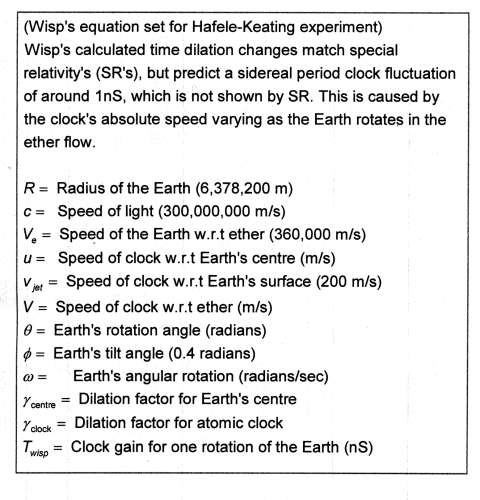
Wisp's equation set for Hafele-Keating experiment continued below
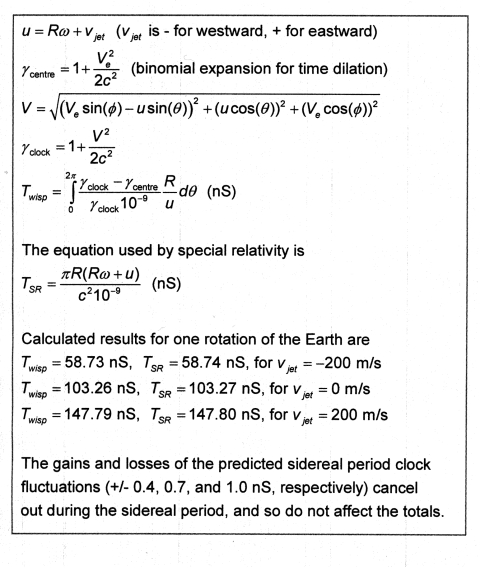
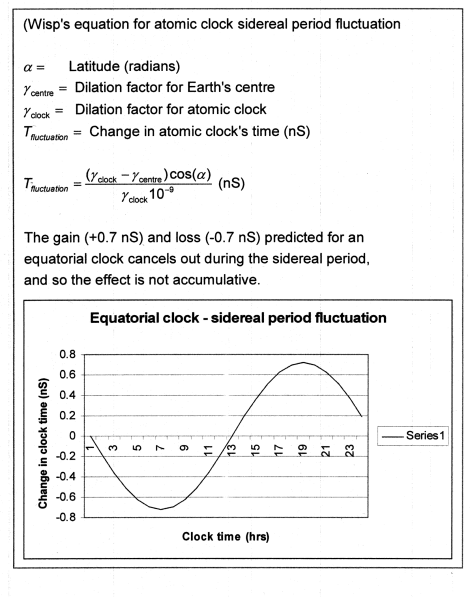
The U.S. Naval Observatory Master Clock keeps accurate to 0.1nS each day and it is used by other systems to ensure they keep within narrow tolerances (wisp theory predicts the master clock's time will fluctuate by +/- 0.5nS). At best these systems (including GPS) are accurate to about 10nS. Soon newer systems will be able to detect the predicted sidereal period variations in equatorial clocks.
GPS satellites would be affected by sidereal period fluctuations ranging from 0nS (orbits perpendicular to ether flow) to 16nS (orbits parallel to ether flow). However, fluctuation changes to their clocks could be interpreted as variations in orbit, and so the effects are masked. Remember, we do not know with accuracy the actual positions of GPS satellites; we can only make predictions based on models. And so it would be sensible to measure this effect on Earth based clocks close to the equator.
For further details on the Hafele-Keating experiment, see
http://hyperphysics.phy-astr.gsu.edu/hbase/relativ/airtim.htmlThe reader may find the article in the link below interesting. Alan Kostelecky discusses research into Lorentz symmetry with regard to a directional component in spacetime. So far no evidence has been found of deviation from observer Lorentz invariance. Wisp theory predicted this, see chapter 8 # 8.3, "There can be no doubt that the ether is responsible for the effects of the electromagnetic force, and since the force is the same in all frames, Lorentz symmetry - also known as observer Lorentz invariance - is supported in an ether flow".
The directional component is simply the ether wind, and it causes tiny sidereal fluctuations in the rates at which clocks tick. However, observers and measuring devices that travel with the clocks will be unable to measure these changes, as their systems undergo equal change, which cancels out the effect. An independent observer using a reference clock situated at the North/South Pole (a different inertial frame) would be able to measure the effect. See
http://www.physics.indiana.edu/~kostelec/
Recommended reading
Although wisp theory's views may differ to the theories on these websites, we all share the view that Einstein's relativity is false. These sites expose weaknesses in Einstein's relativity, and give insight into the obstacles faced by those who challenge his theory. I've updated the links but there are 1000s more new sites - too many to list - that are all saying the same thing - Einstein was wrong.
- Daniel Gezari 2009 - Lunar Laser Ranging Test of the Invariance of
c. See
https://arxiv.org/vc/arxiv/papers/0912/0912.3934v1.pdf - Daniel Gezari 2009 - Experimental Basis for Special Relativity in
the Photon Sector. See
https://arxiv.org/abs/0912.3818
- L. Essen. Wireless
World 1978 - Relativity and time signals. "the continued acceptance
and teaching of relativity hinders the development of electromagnetic
theory". See
https://www.gsjournal.net/Science-Journals/...Relativity%20Theory/Download/3297
- L. Essen. Wireless World 1988 - RELATIVITY - joke or swindle? See
http://www.ekkehard-friebe.de/Essen-L.htm - Richard Muller - The Cosmic Background Radiation and the New Aether
Drift
https://www.jstor.org/stable/24955732 - Roger Penrose (1989). The Emperor's New Mind: "Concerning Computers,
Minds, and Laws of Physics". New York and Oxford: Oxford University
Press, see Andromeda paradox Wikipedia
- Stephan Gift - 2012 - GPS and the One-Way Speed of Light. See
https://vixra.org/pdf/1110.0037v1.pdf
- Stephan Gift - Light Speed Invariance is a Remarkable Illusion. See
https://arxiv.org/abs/0708.2687 - Challenging Einstein's Special Relativity: Herbert Dingle - Science
at the Crossroads. See
http://blog.hasslberger.com/2007/02/challenging_einsteins_special.html
- Physicsmyths.org.uk - special relativity. See
http://www.physicsmyths.org.uk/#specrel - Li Zifeng. The Essence of Special Relativity and Its Influence on
Science-Philosophy and Society. See
http://www.ekkehard-friebe.de/The-essence-of-special-relativity.pdf
- Professor Reginald Cahill - The Einstein Postulates: 1905-2005. A
critical review of the evidence. See
https://arxiv.org/pdf/physics/0412039
- Professor Reginald Cahill - The Roland De Witte 1991 Detection of
Absolute Motion and Gravitational Waves, see
https://arxiv.org/abs/physics/0608205
- Bryan G. Wallace - The Farce of Physics. See
http://www.ekkehard-friebe.de/wallace.htm
- R. Webster Kehr - The detection of ether, see
https://www.vfedtec.com/doc/kehr/the_detection_of_ether.pdf
- David de Hilster's site - Documentary film about Einstein being wrong.
See
https://einsteinwrong.com/site/ - Stefan Marinov - skeptic of Einstein's relativity theory who performed
experiments showing the anisotropy of the velocity of light.
See http://en.wikipedia.org/wiki/Stefan_Marinov#cite_note-Marinov1972-3
- Erim Han 2009 - Alice Law. See
http://www.aliceinphysics.com - Christos Tsolkas - Website - The theory of relativity is wrong, see
http://tsolkas.gr/html/english.html
Other useful sites
- Natural Philosophy Alliance
https://www.naturalphilosophy.org/site/ - Online Science Magazine for Critical Thinkers
https://beyondmainstream.org/
Response to Tom Roberts, "What is the experimental basis of Special Relativity?" http://math.ucr.edu/home/baez/physics/Relativity/SR/experiments.html
- Tom presents statements that are biased in favour of SR. He says:
3.2 One-Way Tests of Light-Speed Isotropy
Note that while these experiments clearly use a one-way light path and find isotropy, they are inherently unable to rule out a large class of theories in which the one-way speed of light is anisotropic. These theories share the property that the round-trip speed of light is isotropic in any inertial frame, but the one-way speed is isotropic only in an aether frame. In all of these theories the effect of slow clock transport exactly offset the effects of the anisotropic one-way speed of light (in any inertial frame), and all are experimentally indistinguishable from SR. All of these theories predict null results for these experiments. See Test Theories above, especially Zhang (in which these theories are called "Edwards frames").
My response to the following comments is in italics.
[Note that while these experiments clearly use a one-way light path and find isotropy, they are inherently unable to rule out a large class of theories in which the one-way speed of light is anisotropic.]
"The oneway experiments he then lists are based on Einstein's clock synchronization method (which we know is rigged to fix the speed of light to be constant). The "large class" refers to ether theories. Tom believes that experiments that are inconsistent with SR are not acceptable, and his criticism of them shows personal bias".
[These theories share the property that the round-trip speed of light is isotropic in any inertial frame, but the one-way speed is isotropic only in an aether frame.]
"The fact that SR rigs the result to give a constant speed of light is not mentioned. And even if an observer moving through the ether detected anisotropy, relativity would reject it".
[In all of these theories the effect of slow clock transport exactly offset the effects of the anisotropic one-way speed of light (in any inertial frame), and all are experimentally indistinguishable from SR.]
"This is not true. The time dilation effects due to slow clock transport are negligible and can be ignored. There is no experimental evidence to back up this claim. If slow clock transport experiments are done they will show up sidereal time variations due to ether flow, which are predicted by ether theories but inconsistent with SR. See Wisp's one-way speed of light experiments".
All of these theories predict null results for these experiments. See Test Theories above, especially Zhang (in which these theories are called "Edwards frames").]
"This is not true. Wisp theory predicts clocks on the equator suffer sidereal period variations of +/- 0.7nS, which cannot be accounted for with SR. There is one important thing that Tom fails to mention about SR: the constancy of the speed of light result is fixed (rigged), and such SR should be wholly rejected".
Home --
About Me -- Reasons
why Einstein was wrong -- One-way
speed of light experiments -- Hot
topic -- Q&A -- ACES
- The end of Relativity --
Book Contents -- Introduction
-- 1 Matter,
Space and Time -- 2
Symmetry -- 3
Fractals -- 4 Wisp Space
-- 5 Gravity -- 6
Electromagnetic Force --
7 Wisp & S.R: Fundamentals
-- 8 Wisp & S.R: Electrodynamics
-- 9 Wisp
& S.R: Doppler effect -- 10
Wisp & S.R: Relativistic Mechanics --
11 Big bang -- Appendix
A -- Appendix B -- Index
A-Z -- Copyright -- Feedback
